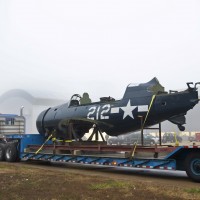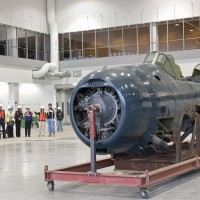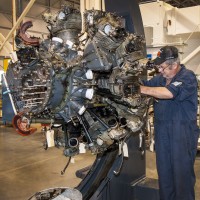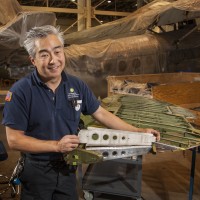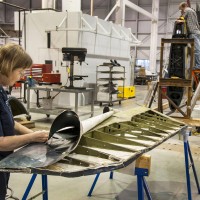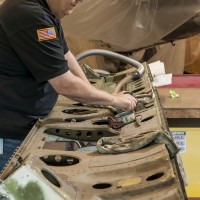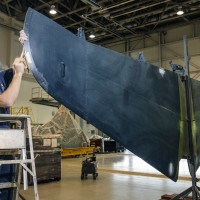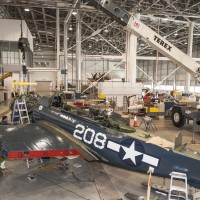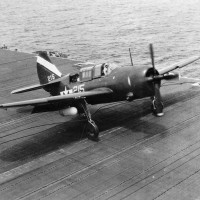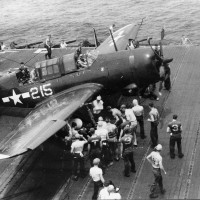Restored and ready for inspection, sir!
A World War II dive-bomber, the Curtiss SB2C-5 Helldiver, rolled off the assembly line in Columbus, Ohio, in May, 1945, four months before the war ended. It never saw combat. From September through December of that year, it was located on the USS Lexington and flown by Bombing Squadron (VB) 92 in the western Pacific and, later, in occupied Japan. It was transferred by the U.S. Navy to the Smithsonian in 1960.
The old veteran will finally come out of retirement on April 1, when it goes on display at the Steven F. Udvar-Hazy Center, where it has been undergoing restoration for the past 15 months. It is the first historic aircraft to be restored in the Mary Baker Engen Restoration Hangar, which is part of a major new addition to the center, also consisting of several artifact storage facilities, a collection processing unit, the Emil Buehler Conservation Laboratory and the museum’s Archives. The restoration hangar, large enough to hold seven aircraft at the same time, is fully visible from a mezzanine above,
where museum visitors can view specialists working on artifacts below.
The restoration of the museum’s Helldiver was aided by two surviving members of VB 92, who provided aeronautics curator Jeremy Kinney with firsthand knowledge of its use on the Lexington; the children of other members donated a squadron yearbook with photographs documenting its unique markings. Another source of information was a former member of the Curtiss-Wright Engineering Cadettes, who inspected Helldivers at the Ohio plant in May 1945. The Cadettes were women engineers during World War II.
The restored Helldiver boasts new paint and markings that take it back to its days with VB-92 during the fall of 1945. The engine received a thorough cleaning and preservation treatment. It has a fully restored propeller with significant details that had been lost for decades. Interior areas in the fuselage were preserved, as were the wings, to stabilize corrosion and retain the original Curtiss Green paint as much as possible. The Helldiver was reconstructed where needed. Museum Collections specialists replicated important parts of the aircraft, including the rear cockpit floor, the gun truck that connects the twin .30-caliber machine guns to the rear seat and the unique Curtiss-specific fabric coverings for the ailerons, elevators and rudder. Heavily damaged components, primarily the rudder and a torn outer wing panel, required extensive repair.
During World War II, U.S. Navy bombing squadrons flew Helldiver dive-bombers against Japan from November 1943 until the war’s end in September 1945. About 30 Navy squadrons operated Helldivers aboard 13 carriers. Changes in carrier tactics, technology and weapons made dive-bombing—delivering a bomb at a steep angle to increase accuracy—obsolete as the war progressed. The Helldiver was the last dive-bomber operated by the Navy and the last significant combat aircraft produced by Curtiss-Wright Corporation.
Support for the Mary Baker Engen Restoration Hangar included a donation of $15 million from Travis and Anne Engen, the son and daughter-in-law of Vice Adm. Donald D. Engen, a former director of the museum, who flew Helldivers in World War II. In appreciation for the gift, the museum named the hangar after Adm. Engen’s wife, Mary.
- One early November morning in 2010, Museum staff moved the fuselage of the Curtiss SB2C-5 Helldiver from storage at the Paul E. Garber Preservation, Restoration, and Storage Facility in Suitland, Md. to the Steven F. Udvar-Hazy Center in Chantilly, Va. (Photo by Dale Penland)
- The Curtiss SB2C-5 Helldiver was the first aircraft moved into the Mary Baker Engen Restoration Hangar, and for a time it was the only aircraft in the immense hangar. (Photo by Mark Avino)
-
Collections specialist Scott Wood examines the engine of the Curtiss SB2C-5 Helldiver, the first aircraft to be restored in the Mary Baker Engen Restoration Hangar at the Steven F. Udvar-Hazy Center in Chantilly, VA.
Collections specialists began work in early 2013 by examining, documenting, and cleaning sections of the aircraft prior to restoration. (Photo by Dale Penland)
- Museum specialist Will Lee fabricated this rudder rib using plans on file in the National Air and Space Museum’s Archives. (Photo by Dane Penland)
- Museum specialist Anne McCombs removes old fabric covering from Helldiver’s elevator, while Matthew Swasta (in background) works on the wing center section.(Photo by Dane Penland)
- Museum specialist Carl Schuettler does initial cleaning of one of the Helldiver’s two bomb bay doors. (Photo by Dane Penland)
- Museum specialist David Wilson prepares the tail horizontal section for painting. (Photo by Dane Penland)
- On March 4, 2014, the Curtiss SB2C-5 Helldiver’s engine is lifted by crane into place. (Photo by Dane Penland)
- The only known VB-92 Helldiver to be photographed up close, “215” flown by Ensign Bob Sobey, illustrates the geometric symbol scheme of the squadron’s early days on USS Lexington. This photograph and others served as the guide for the Museum’s restoration project.(Photo courtesy of Robert L. Lawson Photograph Collection, National Naval Aviation Museum.)
- The only known VB-92 Helldiver to be photographed up close, “215” flown by Ensign Bob Sobey, illustrates the geometric symbol scheme of the squadron’s early days on USS Lexington. (Photo courtesy of Robert L. Lawson Photograph Collection, National Naval Aviation Museum)
Posted: 27 March 2014
-
Categories:
Air and Space Museum , Feature Stories , History and Culture
